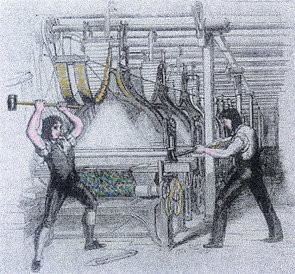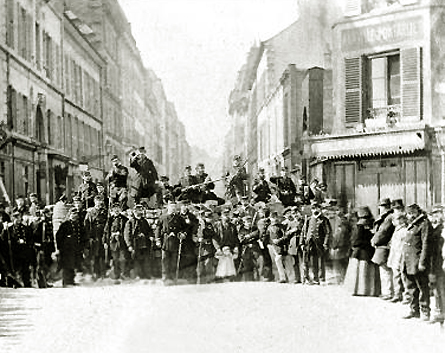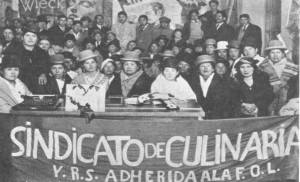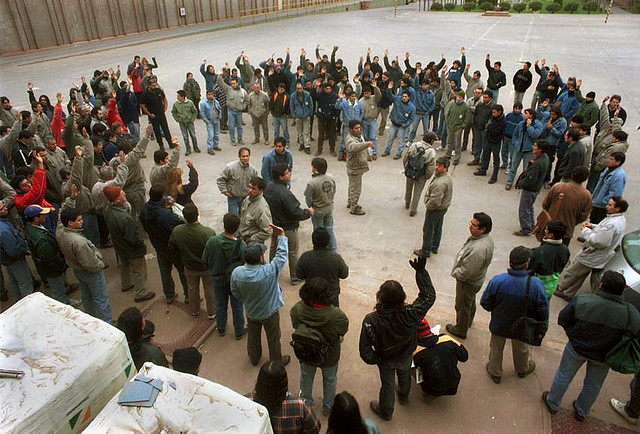“Their needs are so few that they do not wish to adopt civilized habits. What we call conveniences and comforts are not sufficiently valued by them to cause them to undertake to obtain them by their own efforts … the great majority look upon the white man’s ways with indifference and contempt.” Nathan Meeker, US reservation agent to the western Utes, 1879. Quoted in Dee Brown – Bury My Heart at Wounded Knee.
…
Capitalism has been a devastating success. The global capitalist economy is better than any previous system at producing massive quantities of commodities, and moving them around the world. Many millions of people in the “developed” world use, horde, and waste masses more stuff than their ancestors could ever imagine. Other billions of people in the “third world” can dream of joining them.
But capitalism can’t last much longer in its current form. It is based on rapid growth, promising more and more commodities for everyone. This massive growth has been fuelled by cheap energy: seeming limitless supplies of oil and other fossil fuels; and an ecosystem that can absorb seemingly endless destruction. These resources are running out. The damage of global climate change is already irreversible. Capitalism has dramatically shifted the earth’s ecosystem, with implications that will be disastrous for most humans and animals on this planet.
But capitalists face major collective action problems: to solve their economic and ecological crises, corporations and states need to cooperate globally in ways they have never been able to achieve. Most likely they won’t be able to do this. Markets and states will try to carry on as before, but keep on getting hit by new crises. Without growth, governments will not be able to keep us feeling “included” in prosperity.
Unfortunately this doesn’t mean that capitalism is doomed. It may, once again, re-invent itself and survive in new forms. Probably crueller forms than even before. If elites cannot maintain social order with the carrot, they will turn more and more to the stick, keeping us down by force.
In some respects, history seems to be turning backwards. Like in capitalism’s earlier days, we will live in societies of drastic inequality and violent social conflict. Billions of people will be left out of the “dream” of growth and consumption. Many will die.
What other dreams do we have today to inspire resistance? What other cultures and forms of life will have the power to destroy capitalism and create new futures?
…
Marxism is dead
The dream of Marxist socialism has, thankfully, died. The idea was that the state can step in to “plan” mass economies, playing the role filled by markets in a capitalist system. State technocrats could work out what goods needed to be produced, and where they needed to be distributed. The people would be happy as the system worked efficiently. The officials, despite their massive power, would somehow be immune from corruption and tyranny. It didn’t work. State planning did not produce stuff as efficiently as capitalism. Socialist officials, just like other officials, used their power to set themselves up as a tyrannical elite, a “new class” just as vicious as the worst capitalists.
Not a monolith
We keep saying that capitalism is not a monolith. This means: first of all, it is formed of many interlocking institutions and forms of life, all of which are continually open to change. You might imagine capitalisms without advertising, for example, or even without banks, or maybe even without states or families – though they would be very different kinds of capitalism from the one we know now.
But also, not all the institutions and relationships we live with now are fully capitalist. States, or families, or churches, for example, have changed dramatically in the last few hundred years, but they existed before. And even within a highly capitalist society lots of things are going on which are not very capitalist at all.
The anarchist Kropotkin often used to point out lots of examples of what he called “mutual aid” at work even in very capitalist environments. For example, even institutions like the Red Cross, or mutual insurance systems for shipowners, which were set up by capitalist businessmen, worked on quite non-capitalist principles. And our everyday lives are not run on the profit motive. Most people don’t exchange their time for money with their friends or lovers. We help someone in need in the street without calculating how much it should cost. People still choose to fight and die for things they believe in.
So even in our lives under capitalism, we can find of models and practices that can help us see how to live differently. And we don’t have to start from scratch. If you dig underneath the failed history of state socialism, you can see people have been thinking about, working on, and fighting for different cultures for hundreds of years.
Anarchy
Not all of these people, by any means, have been or called themselves anarchists. But before we look further at some examples, we want to mention anarchism, as it is the idea and tradition that my own heart beats to. Anarchism, as we understand it, means fighting for a life free of all kinds of domination and oppression. Not just the oppression of capitalism, but all kinds of domination. And not just in some perfect world “after the revolution”, but also right here, right now.
Or here is the beautiful way one anarchist called America Scarfó put it in the 1920s, sixteen years old at the time:
“I believe that, thanks to our free actions, individual or collective, we can arrive at a future of love, fraternity and equality. I desire for all just what I desire for myself: the freedom to act, to love, to think. That is, I desire anarchy for all humanity. I believe that in order to achieve this we should make a social revolution. But I am also of the opinion that in order to arrive at this revolution it is necessary to free ourselves from all kinds of prejudices, conventionalisms, false moralities and absurd codes. And, while we wait for this great revolution to break out, we have to carry out this work in all the actions of our existence. And indeed in order to make this revolution come about, we can’t just content ourselves with waiting but need to take action in our daily lives. Wherever possible, we should act from the point of view of an anarchist, that is, of a human being.”
In 2014, there’s no sign of a great revolution breaking out any time soon. But that doesn’t stop us trying to live and breathe free every day.
‘So, when these gentlemen say, ‘You are utopians, you anarchists are dreamers, your utopia would never work’, we must reply, ‘Yes, it’s true, anarchism is a tension, not a realisation, not a concrete attempt to bring about anarchy tomorrow morning’. But we must also be able to say but you […] what have you gentlemen accomplished? A world worth living in? Or a world of death, a world in which life is a flat affair, devoid of any quality, without any meaning to it? A world where one reaches a certain age, is about to get one’s pension, and asks oneself, ‘But what have I done with my life? What has been the sense of living all these years?”’ (Alfredo Bonnano:’The Anarchist Tension’)
America Scarfo
……
2. A potted history of other worlds.
We don’t have to start from scratch. If you dig underneath the failed history of state socialism, you can see people have been thinking about and working on many different anti-capitalist alternatives for hundreds of years.
Communist Utopias
Historians like to say that early capitalism was a radical force overturning old feudal structures. This story hides the fact that there were much more radical ideas and movements around already. Revolutionary ideas were often clothed in Biblical language — the supposed slogan of the English peasant rebels of 1381 was “when Adam delved and Eve span, who was then the gentleman?” Heretical sects throughout Europe, as also in the Muslim world, formed communities without private property or hierarchies. Most were wiped out with extreme violence. In 16th century Germany some 300,000 peasants rebelled against feudal authorities in the Peasants Wars, and published a charter of “12 Demands”. Perhaps 100,000 of them were massacred. Soon afterwards appeared the Anabaptists, a radical Christian communist movement mainly in Germany and the Netherlands. In the English Revolution of the 1640s similar ideas reappeared. The Diggers called for people to defy property law, occupy unused land and farm it in communities. Some “Ranters” were still more radical: they opposed the family, or even religion altogether.
Defending old ways.
Throughout history, radical movements have looked both forwards and back: proposing new alternatives for the future; whilst defending existing spaces against capitalist attacks. German peasant rebels, English Diggers, or later anti-enclosure rebels defended ancient rights to the use of “common land”. The Luddites and other early workers’ movements defended traditional arrangements on wages and working conditions which were being swept away by the capitalist market. Similarly, Russian peasant revolutionaries in the 19th and 20th centuries saw the traditional village commune or “mir” as a possible base for a future without either capitalism or the Tsarist state. More recently, the Zapatista uprising in Mexico uses traditional systems of village self-government and collective land rights. To sum up: as well as inventing new ways, anticapitalism can involve defending pre-capitalist traditions of mutual aid which are still alive – because they have been fought for in centuries of previous struggle.
…
Old ways
Throughout history, revolutionary movements have looked both forwards and back: developing new ways for the future; whilst defending existing cultures against capitalist attacks. German peasant rebels, English Diggers, or later anti-enclosure rebels defended ancient rights to the use of “common land”. The Luddites defended traditional arrangements on wages and working conditions which were being swept away by the capitalist market. Russian peasant revolutionaries in the 19th and 20th centuries saw the traditional village commune or “mir” as a possible base for a future without either capitalism or the Tsarist state.
There is little left of these European movements but their histories. In other parts of the world, capitalism has not yet entirely wiped out resisting traditional cultures. There are peoples like the Mapuche of South America, or the Mi’kmaq in the North, to name just two examples, who never fully ceded their lands and cultures to the invaders, and are still fighting today. Recent decades have seen a resurgence of indigenous struggles in many parts of the world, one very well known example being the Zapatista uprising in Mexico which combines traditional systems of village self-government and collective land rights with influences from recent anti-capitalist movements.
Mutualism and cooperatives
Industrialisation increased rapidly in 19th century Europe, as millions were thrown off the land forced to join the new urban “proletariat”. Many of the first urban workers to form radical anticapitalist movements were skilled artisans who still maintained some independence. In France and other European countries, the ideas of the anarchist printer Proudhon were very influential. Proudhon and others sought to organise skilled workers into co-operative workshops which would share tools, knowledge, and defend each other against the bosses. Cooperatives of workers in different trades, and different towns, would then form federations to exchange their products and resources. (So Proudhonist federalism did involve some level of exchange at a bigger level, as well as mutual aid at the level of individual coops.) The idea was that these cooperative federations, by pooling their resources, could become altogether independent of capitalist markets. Thus they would create the “new society in the shell of the old”.
Cooperative movements have shown a number of weaknesses. They were often easily co-opted and assimilated by ‘reform’: the English co-operative movement, basically just an ‘ethical business model’ linked to the Labour Party, is an obvious example. And they often failed to involve the people who really have the most to win, and least to lose, in the struggle against capitalism: the dispossessed masses of the unskilled, unemployed, and work-refusing. In the last decades of the 19th century Proudhonism in France and elsewhere was eclipsed both by Marxism and by more militant anarchisms of the dispossessed, which would fight for freedom right here and now.
A barricade of the Paris commune (Rue Saint Sebastien, 10th arondissement).
Insurrection
In 1534 Anabaptist rebels took over the city of Muenster in Germany and set up an early form of socialist commune. Just one of many uprisings throughout history that hoped to create new worlds. A particularly important insurrection of the 19th century was the Paris Commune of 1870. Although the elected government of the city commune was not radically anti-capitalist, people in the working class neighbourhoods on the outskirts took things much further. They came together voluntarily to organise everything from defence militias, to canteens and first aid clinics, to free self-run schools, and redistribute clothes and supplies. The commune lasted just two months before it was brutally destroyed by government troops. But it inspired many for the future.
In the last decades of the nineteenth century, Marx’s programme for the workers to take state power and abolish capitalism through parliamentary elections won over many workers’ movements. But others, including most anarchists, saw popular uprisings as the basic tool to destroy capitalism. Peter Kropotkin, in his The Conquest of Bread, was one influential anarchist who tried to think from the lessons of Paris and other uprisings about how an insurrectionary population could manage its resources. He argued that any successful insurrection must immediately reclaim all private property from the rich and establish an ‘anarchist communist’ system of mutual aid, where everyone is fed, clothed and housed according to their need, and collective decisions are made by free assemblies.
The world’s most famous insurrectionary period was the Russian Revolution of 1917, which eventually led to Lenin’s Bolshevik party taking state power. Initially, the Bolsheviks took up popular communist slogans calling for ‘all power to the Soviets’, local assemblies of workers and peasants. But once in charge they turned the soviets into hollow shells controlled by the party, and established a brutal dictatorship.
Recent decades have see new ideas of ‘insurrectionary anarchism’ flourish. One influential anarchist here is Alfredo Bonnano, who in the 70s and 80s in Italy called for ‘anarchists of action’ to focus on preparing and participating in insurrections, and continues to be a strong voice for uncompromising attack on the state and capital.
The latest wave of insurrections in the ‘Arab Spring’ have, as so often through history, turned to tragedy and counter-revolution. One positive note is that they have helped spark anarchist and anti-authoritarian ideas in the Arab world, and lit a chain of fires that are still burning as far away as Brazil.
CNT worker run armoured car factory, Barcelona 1936.
Workers’ control
The first mass workers’ movements appeared in the factories and slums of the late 19th century. At the turn of the 20th century a new organising strategy emerged that many thought could overturn capitalism – revolutionary syndicalism. Millions of workers had now joined radical trades unions open to all, skilled and unskilled. The idea was that factories would be run by workers directly, through their union assemblies; the big unions’ federal structures would take over coordinating the distribution of the different factories’ inputs and outputs. So: the same structures that workers had built for strikes and self-defence would turn into the basic economic institutions of the new world.
By the 1910s, syndicalism seemed to have a real chance in many European countries. Theorists like Pataud and Pouget, activists in the French CGT union, had their plans ready: when the moment was right, a massive general strike would collapse capitalism, and the new workers’ organisations would step in. Faced with this threat, the capitalist elites fought back with extreme repression, imprisonments, assassinations against workers’ leaders. But what ultimately saved capitalism was probably the First World War, a bloodbath of nationalist destruction. And then the Russian Revolution: the seeming success of the authoritarian Bolshevik “communists” in Russia undermined anarchist and syndicalist movements, as many switched to their model of party and state-led revolution.
The most serious syndicalist movement to survive was in Spain. In 1936 the anarchist CNT union put a form of syndicalism into practice in Catalonia for a few short months, before it was wiped out by Franco’s fascist armies – supplied by Germany and Italy, and tacitly supported by all the capitalist states of Europe – as well as being attacked from within by Stalinist agents.
Syndicalist cooking union, La Paz, Bolivia, 1935.
From 1917 until 1990 worker resistance was often smothered by the Russian (and Chinese) backed Communist Parties. They funded and co-opted workers’ movements, turning on any that threatened to upset their grip on power. And yet pockets of resistance always kept reappearing – and more so as the Soviet empire weakened in the 1970s. In Italy there was a wave of factory occupations, where workers took over their workplaces and ran them with workers councils. A movement of “workers control” also grew up across the Iron Curtain in Yugoslavia. Similar movements in Latin America were largely wiped out by US-backed totalitarian dictatorships. But these ideas would resurface in Argentina in 2001 when workers occupied factories deserted by capital after the economic crash.
Some factory occupations have been appearing again in crisis-hit European countries, particularly Greece. But undoubtedly the main area worker rebellion now in the manufacturing zones of Asia, and especially China. If new industrial workers’ movements are going to develop that can pose a real threat to capitalism, it will happen there.
Many anarchists strongly criticised syndicalist strategies from the start. Like mutualist movements, in practice syndicalist organisations have moved far from their declared principles. The French CGT turned into a standard reformist trade union. The Spanish CNT largely became an authoritarian structure in which, infamously, in 1936 four of its anarchist leaders decided to become government ministers. By this point the organisation had developed a centralised bureaucracy in which decisions were completely out of the hands of ‘rank and file’ workers. These mass-scale organisations were too big, formalised, and hierarchical to resist becoming mirrors of the system they hoped to destroy. Can worker movements of the 21st century develop new ways of organising that avoid these traps?
Workers’ assembly at Zanon occupied factory, Argentina.
DIY culture
In the richest countries like France, West Germany, UK, or US, workers’ resistance had all but disappeared by the mid 20th century, incorporated into tame trade union and parliamentary movements. But radical ideas were kept alive by flourishing “counter-cultural” movements mainly of students and youth. The student rebellions of 1968 revived interest in anarchist ideas. New anarchist and anti-authoritarian thinking saw how consumer capitalism was now effectively commodifying and colonising not just work but every aspect of our individual lives.
In the 1970s, punk appeared with its rebellious ethic of “Do It Yourself” (DIY). Punk squatters and drop-outs lived off the excessive waste of consumer society in the rich world where food, clothes, and all kinds of goods are simply tossed away unneeded into the street.
Living off the scraps of rich cities doesn’t offer much of a challenge or alternative to capitalism. But there is value in the experimental ethos of DIY culture, and its attacks on passive consumer values and on all hierarchies and bureaucracies.
Prestes Maia squat, Sao Paulo, Brazil. The banner reads “We are Zumbi (rebel slave leader)”.
After civilisation
Many 19th and 20th century anti-capitalists and anarchists had no problem with the industrial economy. Kropotkin in The Conquest of Bread put great faith in the advance of labour-saving technologies to improve the lives of city-dwelling masses. Syndicalists rarely mounted any critique of mass production or division of labour, so long as the factories are run by workers’ committees.
Now we are starting to feel the ecological, as well as the human, costs of industrial life, these positions are untenable. There is no way a system of mass industry based on fossil fuels can continue for much longer, and in the process of its collapse it will transform the earth’s climate and ecosystems beyond recognition. Capitalism is not going to provide any smooth ‘transition’ away from mass industry, and in any case rapid global warming processes are now irreversible.
Our dreams of the future, and our projects of struggle, need to recognise this. How will we deal with the ecological and population crises to come?
We are not going to try and deal with this massive question in any depth here. Here are just some immediately obvious points:
** any sustainable new cultures must involve smaller-scale, simpler ways of living
** they will have to deal with major upheavals including ‘natural disasters’, mass migrations and resource wars
** conditions will be very different in different global and climactic zones as some areas become desert or flooded, rich regions fortify their borders against climate refugees, etc.
Most anarchists and other anti-capitalists have barely begun to think about the implications. One book that raises many important issues is Desert, by Anonymous.
Various strands of ‘green’ anarchism have focused on developing small-scale forms of life. In the 1990s and early 2000s, above all in the US, one flourishing tendency was primitivism, which advocates returning to pre-industrial, and indeed pre-agricultural, social arrangements. Primitivism is part of a wider anti-civilisation critique in recent anarchism: we need to break from enlightenment ideas of civilisation and progress, from seeing the world as property of human beings. An ‘anti-civ’ perspective does not necessarily mean primitivism, which can be criticised for romanticising ancient cultures and, often, ideas of ‘human nature’. We may have things to learn from hunter-gatherers and other ‘barbarians’, but we have to actively create our own forms of life, under very different conditions from our ancestors. To quote the anarchist Wolfi Landstreicher:
‘If civilization were to be dismantled in our lifetime, we would not confront a world of lush forests and plains and healthy deserts teeming with an abundance of wildlife. We would instead confront a world full of the detritus of civilization — abandoned buildings, tools, scrap, etc., etc. Imaginations that are not chained either to realism or to a primitivist moral ideology could find many ways to use, explore and play with all of this — the possibilities are nearly infinite.’ (Wolfi Landstreicher – ‘A Critique, Not a Program: For a Non-Primitivist Anti-Civilization Critique’.)
And moving away from mass society does not have to mean abandoning all recent technologies. In the 18th and 19th centuries technological ‘advances’ came together with massification, division of labour, and concentration of people in factories. More recent information technologies often do the opposite: “all purpose computing” means any of us can become a designer, engineer, artisan with one small machine; “future manufacturing”, e.g. 3-D printing, means that we can manufacture even very advanced technological products locally; phenomena like free software suggest possibilities for long-distance communication and mutual aid without mass concentration or financial exchange.
Geeky people in their “hackspace”, or tool-sharing workshop.
……
Now and tomorrow
Capitalism survives by spinning dreams. The basic story all over the world is the same: just hold on a bit longer, and you can have your place in the capitalist dream too. We are living at the end of this dream. Crises of capitalism are opportunities to break free and make different ways of living. But these opportunities mean nothing unless we take them.
Look at Europe right now: millions of people, especially the young, migrants, the unskilled, and everyone else at the bottom, are being cut off from the job market and the welfare state. Like village dwellers in past centuries, we are being dispossessed. If we can make new cultures, and build new alliances and communities of the dispossessed around them, then we have a serious chance. But this won’t happen automatically, just because conditions are getting bad. We have to make it happen.
How can we do this? There is no point trying now to draft a grand plan of what a post-capitalist society would look like. At best, it would be irrelevant as struggles and situations shift. At worst, it would be a fetish or a dogma tying us down. Most urgently, we need to find ways to struggle right now. And that is how we learn what structures can work, by living them in practice. And we can aim to create structures that are versatile, that can develop and play new roles as situations change.
We can learn a lot from the history of past non-capitalist and anti-capitalist cultures. But we don’t live in 1871 or 1936. We also need to experiment, create, and develop in practice, our own new forms of life, learning as we do so. These forms of life must be fighting cultures, which can destroy capitalism.
……
More reading:
For the story of Meeker’s complete and brutal incomprehension of a superior culture, and many other sad stories, see Dee Brown – Bury My Heart at Wounded Knee (An Indian History of the American West).
Anarchism
Many people have written introductions to anarchism, short and long, and we find it hard to recommend any particular one. A couple of classics from the early 20th century are Alexander Berkman – What is Anarchism? and Errico Malatesta – Anarchy.
There are many many more introductory and other anarchist texts at the amazing website theanarchistlibrary.org. At this moment, the category ‘introductory’ has 70 entries. Of all the recent short ‘introductions’, perhaps the best written one is ‘Anarchy 101‘ by Bob Black. We don’t agree with all of it by any means, but one of the good things about anarchism is that we don’t all have to agree.
The first quote in this section is from a letter that America Scarfo, then 16 years old, wrote to the French anarchist and individualist Emil Armand. She was writing on the subject of free love and her relationship with Severino Di Giovanni, a very active anarchist insurrectionary and propagandist who was killed by the Argentinian state in 1931 – she went on to have a long and active life. The letter is online at http://theanarchistlibrary.org/library/america-scarfo-emile-armand-letter-of-america-scarfo-to-emile-armand
The second quote is from Alfredo Bonanno‘s ‘The Anarchist Tension’, in which he discusses what it means to be an anarchist. Anarchism is not a fixed ideology to be ‘guarded in a safe’, but something each of us has to develop and continually discover for ourselves in action. It is not a distant objective to be achieved ‘after the revolution’, but a joyful struggle for freedom in our life lived every day.
Some early anti-capitalist history
Raul Vaneigem – The Movement of the Free Spirit. On medieval heresies, communes, uprisings, and rejection of the Church’s ideology of ‘survival’ against ‘life’.
Luther Blisset – Q. Radical historical novel featuring German peasants war, Anabaptists, the invention of leafleting, free love, and international bank fraud. Described by its authors as a “handbook of survival skills”. And great fun.
Christopher Hill – The World Turned Upside Down. History of the Diggers, Ranters, Levellers, and others in the English Revolution.
E.P. Thompson – The Making of the English Working Class. Massive scholarly reference on the early period of industrial capitalism in England, and resistance to it. Includes perhaps the most complete history of the Luddite movement.
Mutualism
If you can sort out the interesting stuff from the rabid misogynistic and anti-semitic rants, here is an online archive of Proudhon’s writings:
http://dwardmac.pitzer.edu/anarchist_archives/proudhon/Proudhonarchive.html
Kevin Carson is a contemporary Proudhon-inspired “mutualist” who describes himself as a “free market anti-capitalist”:
http://mutualist.blogspot.co.uk/
Some key essays by Carson and others are collected in this recent book: Gary Chartier, Charles W. John, Kevin Carson (editors) –Markets Not Capitalism
Insurrection
Peter Kropotkin The Conquest of Bread. Classic statement of insurrectionary anarchist communism from 100 years ago. While certainly outdated in some number of ways — e.g., its faith in labour-saving technologies — this is still a great anarchist work on economics. Its main interest is in how to coordinate resources for an insurrectionary society, learning from the experience of the Paris Commune in particular. But also has more insights on economic theory in general, and a critique of Marx’s economic thought and the “labour theory of value” .
On the Paris Commune, for passion and deep personal involvement, we would start with the memoirs of the French anarchist Louise Michel. http://theanarchistlibrary.org/library/louise-michel-memories-of-the-commune
There are many of Alfredo Bonanno‘s writings online in English at theanarchistlibrary.org. Some that directly discuss the idea of insurrection are: Why Insurrection?; Insurrectionalist Anarchism; and From Riot to Insurrection.
Some interesting recent English-language insurrectionalist writing can be found in the US journals Killing King Acabus, Willful Disobedience and Anarchy: A Journal of Desire Armed. Many back-issues of these can be found on theanarchistlibrary.org. In particular look at the short texts written by Wolfi Landstreicher. For instance Against the Logic of Submission. An interesting Landstreicher article discussing a number of recent insurrectionary events around the world and anarchists’ relations with them is: Autonomous Self-Organization and Anarchist Intervention: A Tension in Practice.
Live insurrectionalist websites with short texts and action reports include: 325.nostate.net and actforfree.nostate.net
On the emerging Arab anarchism see texts on the website tahriricn.wordpress.com.
Syndicalism and its critics
Rudolf Rocker – Anarcho-Syndicalism: Theory and PracticeClassic exposition of anarcho-syndicalism from 1938.
Emile Pataud and Emile Pouget – How We Shall Bring about the Revolution. Fictionalised manual for a syndicalist revolution beginning from a general strike, from 1909.
On the success (or otherwise?) of syndicalist economic organisation in Spain 1936 see:
Gaston Laval — Collectives in the Spanish Revolution.
Ursula Le Guin – The Dispossessed. Classic science fiction novel from the 1970s. Although a fantasy novel, this is also one of the best worked out programmes for what an anarcho-syndicalist society (and on a desert planet, too) could actually look like.
For a strong critique of syndicalist organisation and its tendencies to ‘degenerate’ into compromise and authoritarianism see Alfredo Bonanno – A Critique of Syndicalist Methods. Bonnano was writing this in the middle of the resurgence of workplace unrest in Italy in the 1970s. See also Bonanno’s Let’s Destroy Work, Let’s Destroy the Economy.
A classic earlier (1926) anarchist critique of syndicalism is Errico Malatesta – On Syndicalism. Malatesta sees syndicalist organising as a useful means for workers’ struggles, but certainly not the magic road to anarchist revolution that some of its supporters were claiming. http://theanarchistlibrary.org/library/errico-malatesta-on-syndicalism
Also Bob Black – The Abolition of Work
(http://theanarchistlibrary.org/library/Bob_Black__The_Abolition_of_Work.html)
Post-industrial futures
Anonymous – Desert. Any discussion of capitalism and anti-capitalism risks irrelevance unless we consider how drastic climate change is going to remake the world. This book from a UK anarchist opens a crucial debate.
Notable US primitivist writers include John Zerzan and Kevin Tucker. Besides theanarchistlibrary.org there is a dedicated library of primitivist texts here: http://www.primitivism.com/primitivism.htm
Wolfi Landstreicher‘s anti-civ critique of primitivism: http://theanarchistlibrary.org/library/wolfi-landstreicher-a-critique-not-a-program-for-a-non-primitivist-anti-civilization-critique
And another beautifully written feminist Sci-Fi novel:
Marge Piercey – Woman On The Edge of Time. A vision of a society of self-sufficient small scale communes which also raises many issues about gender, sexuality, and cultural identities. Its utopian dreams are embedded in a story of the dystopian present. The bit where the cows telepathically ask people to eat them, though, is pretty silly.












